Djebel 250XC и DR-Z 400 S описание приборной панели (RU, 0.2 MB)
DRZ-250 Service Manual (RU, 43.4 MB)
GSX1250fa-Руководство пользователя (RU, 3.7 MB)
Service Manual Suzuki GSF 400 (RU, 4.8 MB)
Service Manual Suzuki Hayabusa K8+ (EN, 35.2 MB)
Susuki GSX 1300 BK Service manual (EN, 37.0 MB)
Suzuki Boulevard C50 2009 (EN, 2.9 MB)
Suzuki Boulevard M109R сервис мануал (RU, 2.7 MB)
Suzuki Boulevard M90 сервис мануал (EN, 40.1 MB)
Suzuki Burgman (AN400) service manual (EN, 18.1 MB)
Suzuki DL 1000 V-Strom руководство пользователя (RU, 3.5 MB)
Suzuki DR250RX SJ45A Djabbel 250 Parts Catalogue 2004-2 (EN, 17.1 MB)
Suzuki GN250 Service Manual (EN, 30.1 MB)
Suzuki GSF 1200 S 2001-2002 Repair Manual (EN, 18.6 MB)
Suzuki GSF 1250 service manual (EN, 35.2 MB)
Suzuki GSF 400 Service Manual `91-`97 (EN, 49.8 MB)
Suzuki GSF 600 S 2000-02 Manual (RU, 26.2 MB)
Suzuki GSF 650 S K7 Manual (RU, 21.3 MB)
Suzuki GSF1250 service manual (EN, 43.1 MB)
Suzuki GSF600/1200 1996-2001 Haynes service manual (EN, 50.8 MB)
Suzuki GSF650A(SA) 2009г -Руководство пользователя (RU, 4.8 MB)
SUZUKI GSF650A/SA (K9) 2009-Руководство пользователя (RU, 4.8 MB)
Suzuki GSF650A/SA 2009-2012 руководство пользователя (RU, 4.8 MB)
Suzuki GSR 600 — Руководство пользователя (RU, 4.6 MB)
Suzuki GSR 750 technical information (EN, 3.0 MB)
Suzuki GSX 1250 FA Manual (RU, 3.7 MB)
Suzuki GSX 1300 BKA руководство пользователя (RU, 3.7 MB)
Suzuki GSX-R 1100W 93-98 Microfiches (EN, 25.3 MB)
Suzuki GSX-R 1100W 93-98 Service Manual (EN, 61.2 MB)
Suzuki GSX-R 600 K8-K9 Servise Manual (EN, 20.6 MB)
Suzuki GSX-R750 2000-2003 (Y-K3) Parts Catalog (EN, 2.5 MB)
Suzuki GSX-R750 K4-K5 (2004) Service Manual (EN, 20.2 MB)
Suzuki GSX650F Service Manual (EN, 43.1 MB)
Suzuki gsxr 750 К6/К7 — Service Manual (EN, 46.0 MB)
Suzuki Intruder 1400 Reparaturanleitung (DE, 12.5 MB)
Suzuki intruder VS 700/750/800 (1987-2008) (RU, 19.9 MB)
Suzuki Intruder VS700-800 Service Repair Maintenance Manual (EN, 0.4 MB)
Suzuki Intruder VS700-800 часть 10 (EN, 0.8 MB)
Suzuki Intruder VS700-800 часть 11 (EN, 0.5 MB)
Suzuki Intruder VS700-800 часть 12 (EN, 0.6 MB)
Suzuki Intruder VS700-800 часть 13 (EN, 0.2 MB)
Suzuki Intruder VS700-800 часть 14 (EN, 0.1 MB)
Suzuki Intruder VS700-800 часть 15 (элетросхемы) (EN, 1.0 MB)
Suzuki Intruder VS700-800 часть 2 (EN, 0.3 MB)
Suzuki Intruder VS700-800 часть 3 (EN, 0.7 MB)
Suzuki Intruder VS700-800 часть 4 (EN, 1.9 MB)
Suzuki Intruder VS700-800 часть 5 (EN, 0.6 MB)
Suzuki Intruder VS700-800 часть 6 (EN, 0.5 MB)
Suzuki Intruder VS700-800 часть 7 (EN, 0.6 MB)
Suzuki Intruder VS700-800 часть 8 (EN, 0.6 MB)
Suzuki Intruder VS700-800 часть 9 (EN, 0.3 MB)
Suzuki RF 400 -Manual (JP, 22.1 MB)
Suzuki RF 400 Каталог запчастей (JP, 50.4 MB)
Suzuki RF600R service manual (EN, 43.4 MB)
Suzuki TL1000S — Руководство пользователя (English) (EN, 44.5 MB)
Suzuki VL 1500 Intruder service manual (98-00) (EN, 34.2 MB)
Suzuki VL 1500 Intruder руководство пользователя (RU, 6.7 MB)
Suzuki VL1500 Service Manual 1998-2000 (EN, 33.1 MB)
Suzuki VL1500 service manual 1998-2000 (EN, 33.1 MB)
Suzuki VL1500 service manual 1998-2000 (EN, 33.1 MB)
Suzuki VL800 Manual (RU, 3.7 MB)
Suzuki VL800-Руководство пользователя (RU, 3.7 MB)
Suzuki VX 800 Service Manual (EN, 7.7 MB)
Suzuki VZ1500 owner’s manual (EN, 1.7 MB)
Suzuki XF 650 Freewind (ccm 644 Engine) Service Manual (EN, 12.7 MB)
Suzuku AN650 Service Manual (EN, 31.4 MB)
User Manual Suzuki Hayabusa K8-L13 (RU, 3.3 MB)
User Manual Suzuki SV 650 1GEN 1/2 (EN, 5.1 MB)
User Manual Suzuki SV 650 1GEN 2/2 (EN, 4.5 MB)
Каталог запчастей на GSF 750. (JP, 8.3 MB)
Мануал Suzuki SV 650 S (RU, 1.8 MB)
Руководство по сервисному обслуиванию SFV400 (RU, 4.8 MB)
Руководство пользователя SUZUKI GSFA(SA) 2009 (RU, 4.8 MB)
Руководство пользователя Suzuki GSX 650 F 08г-12г (RU, 3.2 MB)
Руководство пользователя Suzuki GSX1250fa (RU, 3.7 MB)
- Manuals
- Brands
- Suzuki Manuals
- Motorcycle
- GSX1250FA
- Owner’s manual
-
Contents
-
Table of Contents
-
Troubleshooting
-
Bookmarks
Related Manuals for Suzuki GSX1250FA
Summary of Contents for Suzuki GSX1250FA
-
Page 1
GSX1250FA OWNER’S MANUAL… -
Page 2
This manual should be considered a permanent part of the motorcycle and should remain with the motorcycle when resold or otherwise transferred to a new owner or operator. The manual contains important safety information and instructions which should be read carefully before operating the motorcycle. -
Page 3
Suzuki parts are WARNING manufactured of high quality materi- als, and machined parts are finished Indicates a potential hazard that to close tolerances. -
Page 4
Your autho- rized Suzuki dealer has experienced technicians that are trained to provide your machine with the best possible service with the right tools and equip- ment. -
Page 5: Table Of Contents
TABLE OF CONTENTS CONSUMER INFORMATION CONTROLS FUEL, ENGINE OIL AND COOLANT RECOMMENDATIONS BREAK-IN (RUNNING-IN) AND INSPECTION BEFORE RIDING RIDING TIPS INSPECTION AND MAINTENANCE TROUBLESHOOTING STORAGE PROCEDURE AND MOTORCYCLE CLEANING SPECIFICATIONS INDEX…
-
Page 7: Consumer Information
CONSUMER INFORMATION ACCESSORY USE AND MOTORCYCLE LOADING ……… 1-2 SAFE RIDING RECOMMENDATION FOR MOTORCYCLE RIDERS ….1-4 LABELS ………………….. 1-5 SERIAL NUMBER LOCATION …………….1-6 NOISE CONTROL SYSTEM (AUSTRALIA ONLY) ……….1-6…
-
Page 8: Accessory Use And Motorcycle Loading
It is not possible for Suzuki to mounted. test each accessory on the market or • Inspect for proper ground clear- combinations of all the available ance and bank angle.
-
Page 9
LOADING LIMIT LOADING GUIDELINES This motorcycle is primarily intended WARNING to carry small items when you are not riding with a passenger. Follow the guidelines below to carry a passenger Overloading or improper loading or cargo: can cause loss of motorcycle con- •… -
Page 10: Safe Riding Recommendation For Motorcycle Riders
MODIFICATION INSPECTION BEFORE RIDING Modification of the motorcycle, or Review thoroughly the instructions in removal of original equipment may the “INSPECTION BEFORE RIDING” render the vehicle unsafe or illegal. section of this manual. Do not forget to perform an entire safety inspection to ensure the safety of the rider and SAFE RIDING RECOMMENDATION its passenger.
-
Page 11: Labels
RIDE DEFENSIVELY LABELS The most common type of motorcycle Read and follow all the labels on the accident occurs when a car traveling motorcycle. Make sure you under- towards a motorcycle turns round cor- stand all of the labels. Do not remove ner in front of the motorcyclist.
-
Page 12: Serial Number Location
SERIAL NUMBER LOCATION NOISE CONTROL SYSTEM (AUSTRALIA ONLY) TAMPERING WITH NOISE CONTROL SYSTEM PROHIBITED Owners are warned that the law may prohibit: (a) The removal or rendering inopera- tive by any person other than for purposes of maintenance, repair or replacement, of any device or element of design incorporated into any new vehicle for the pur- pose of noise control prior to its…
-
Page 13: Controls
CONTROLS LOCATION OF PARTS ………………2-2 KEY ……………………2-5 IGNITION SWITCH ………………..2-5 INSTRUMENT PANEL ………………2-7 LEFT HANDLEBAR ………………. 2-16 RIGHT HANDLEBAR ………………2-19 FUEL TANK CAP ………………..2-21 GEARSHIFT LEVER ………………2-22 REAR BRAKE PEDAL ………………2-22 SEAT LOCK AND HELMET HOLDERS …………2-23 STANDS ………………….
-
Page 14: Location Of Parts
CONTROLS LOCATION OF PARTS 1 Clutch lever 2 Left handlebar switches 3 Clutch fluid reservoir 4 Instrument panel 5 Front brake fluid reservoir 6 Right handlebar switches 7 Throttle grip 8 Front brake lever 9 Ignition switch 0 Fuel tank cap…
-
Page 15
A Main fuse B Fuses C Battery and fuses D Helmet holder E Seat lock F Tools G Passenger grab handle H Engine oil filter I Engine oil drain plug J Gearshift lever K Side stand L Center stand M Footrests N Passenger footrests… -
Page 16
O Rear brake fluid reservoir P Air cleaner Q Rear brake light switch R Rear brake pedal S Engine oil inspection window T Engine oil filler cap… -
Page 17: Key
IGNITION SWITCH The ignition switch has 4 positions: “OFF” POSITION All electrical circuits are cut off. The engine will not start. The key can be removed. “ON” POSITION The ignition circuit is completed and the engine can now be started. The (Canada and Australia) headlight and taillight will automati- cally be turned on when the key is in…
-
Page 18
If the motorcycle falls down, turn “P” (Parking) POSITION the ignition switch off immedi- When parking the motorcycle, lock ately. Ask your authorized Suzuki the steering and turn the key to the dealer to inspect the motorcycle “P” position. The key can now be for unseen damage. -
Page 19: Instrument Panel
INSTRUMENT PANEL The fuel injection system indicator light 8, engine rpm indicator light C, coolant temperature indicator/oil pres- sure indicator light D, LCD’s and tachometer needle work as follows to confirm their function when the igni- tion switch is turned to the “ON” posi- tion.
-
Page 20
NEUTRAL INDICATOR LIGHT “N” The green light will come on when the transmission is in neutral. The light will go out when you shift into any gear other than neutral. TURN SIGNAL INDICATOR LIGHT “” 3 When the turn signals are being oper- ated either to the right or to the left, the indicator light will blink intermit- tently. -
Page 21
SPEEDOMETER 6 To change the display, push the SEL button A. The display changes in the The speedometer indicates the road speed in miles per hour and/or kilo- order below. meters per hour. NOTE: • Set the meter to odometer, then press and hold ADJ button 2 for 2 seconds to switch between km/h and mph. -
Page 22
Reserve trip meter The reserve trip meter counts dis- tance from fuel tank reserve point until the fuel tank is refilled. The fuel mark starts blinking and the reserve trip meter starts counting when the fuel level reaches the reserve point. The trip meter will be reset to zero automatically when the fuel tank is refilled over reserve point and the… -
Page 23
INDICATOR “FI” 8 the engine running and bring your motorcycle authorized Suzuki dealer. If the engine stalls, try restarting the engine after turn- ing the ignition switch off and on. • If the display indicates “FI” contin-… -
Page 24
Make sure that the transmission is turned on, you should have the sys- in neutral or the side stand is fully tem checked by an authorized Suzuki dealer as soon as possible. If the display still indicates “CHEC” after checking the above items, inspect the ignition fuse and the con- nection of the lead wire couplers. -
Page 25
• If it does not go off after starting 2 seconds to change the mode. to ride, ABS is not functioning, and the brakes provide normal stopping ability. You should have the system checked by an authorized Suzuki dealer as soon as possible. 2-13… -
Page 26
Light Brightness Selection Push the SEL button A and the brightness indicator comes on in odometer/trip meter area. Pushing the ADJ button 2 will change light brightness in 5 steps. The brightness indicator indicates brightness from “ ” (min) to “ ”… -
Page 27
If the engine coolant temperature does not go out, have your autho- indicator light comes on, stop the rized Suzuki dealer or a qualified engine to let it cool. Do not run the mechanic inspect your motorcy- engine until the coolant tempera- cle. -
Page 28: Left Handlebar
LEFT HANDLEBAR CLUTCH LEVER 1 The clutch lever is used for disengag- ing the drive to the rear wheel when starting the engine or shifting trans- mission gears. Squeezing the lever disengages the clutch. FUEL METER “” E The fuel meter indicates the amount of fuel remaining in the fuel tank.
-
Page 29
HEADLIGHT FLASHER SWITCH 2 Clutch Lever Adjustment Press the switch to flash the head- light. DIMMER SWITCH 3 “” position The headlight low beam and taillight turn on. “” position The headlight high beam, headlight low beam and taillight turn on. The high beam indicator light also turns The distance between the grip and the clutch lever is adjustable to 4 posi-… -
Page 30
HORN SWITCH “” 5 Press the switch to operate the horn. HAZARD WARNING SWITCH “” All four turn signal lights and indica- tors will flash simultaneously when the switch is turned on with the igni- tion switch in the “ON” or “P” position. Use the hazard warning lights to warn other traffic during emergency park- ing or when your motorcycle could… -
Page 31: Right Handlebar
RIGHT HANDLEBAR Front Brake Lever Adjustment ENGINE STOP SWITCH 1 The distance between the throttle grip “” position and the front brake lever is adjustable The ignition circuit is off. The engine to 5 positions. To change the position, cannot start or run. push the brake lever forward and turn the adjuster to the desired position.
-
Page 32
NOTICE Engaging the starter motor for more than five seconds at a time can damage the starter motor and wiring harness from overheating. Do not engage the starter motor for more than five seconds at a time. If the engine does not start after several attempts, check the ELECTRIC STARTER SWITCH “”… -
Page 33: Fuel Tank Cap
FUEL TANK CAP WARNING If you overfill the fuel tank, fuel may overflow when it expands due to engine heat or heating by the sun. Fuel that overflows can catch fire. Stop adding fuel when the fuel level reaches the bottom of the filler neck.
-
Page 34: Gearshift Lever
GEARSHIFT LEVER REAR BRAKE PEDAL This motorcycle has a 6-speed trans- Depressing the rear brake pedal will mission which operates as shown. To apply the rear disk brake. The brake shift properly, squeeze the clutch light will be illuminated when the rear lever and close the throttle at the brake is operated.
-
Page 35: Seat Lock And Helmet Holders
SEAT LOCK AND HELMET HOLDERS There is a helmet holders under the seat. To use them, remove the seat, hook your helmet fastener ring to the holder and refit the seat. WARNING Failure to install the seat properly could allow the seat to move and cause loss of rider control.
-
Page 36: Stands
STANDS The side stand/ignition interlock sys- tem works as follows: This motorcycle is equipped with cen- • If the side stand is down and the ter stand and side stand to support transmission is in gear, the engine the motorcycle when parking. can not be started.
-
Page 37: Suspension Adjustment
SUSPENSION ADJUSTMENT The standard settings for both the front rear suspensions selected to meet various riding condi- tions such as low to high motorcycle speed and light to heavy load on the motorcycle. The suspension settings can be adjusted to fine-tune then according to your preference.
-
Page 38
The spring pre-load is adjust- NOTE: Ask your Suzuki dealer to dis- able to 7 positions. To change the pose of the rear suspension unit. spring pre-load setting, place the motorcycle on the side stand. -
Page 39: Seat Height Adjustment
1. tory. To change the positions from low The rebound damping force adjuster to high, ask your Suzuki dealer to 1 is located at the bottom of the rear change positions. suspension.
-
Page 41: Fuel, Engine Oil And Coolant Recommendations
FUEL, ENGINE OIL AND COOLANT RECOMMENDATIONS FUEL OCTANE RATING ………………3-2 OXYGENATED FUEL RECOMMENDATION …………3-2 ENGINE OIL ………………….3-4 COOLANT ………………….3-5…
-
Page 42: Fuel Octane Rating
OXYGENATED FUEL FUEL, ENGINE OIL AND RECOMMENDATION COOLANT (Canada and EU) RECOMMENDATIONS Oxygenated fuels which meet the minimum octane requirement and the FUEL OCTANE RATING requirements described below may unleaded gasoline with be used in your motorcycle without octane rating higher jeopardizing the New Vehicle Limited (Research method).
-
Page 43
Suzuki and may not be covered under the Be careful not to spill any fuel New Vehicle Limited Warranty or the when filling the fuel tank. -
Page 44: Engine Oil
ENGINE OIL JASO T903 The JASO T903 standard is an index Use Suzuki genuine engine oil or to select engine oils for 4-stroke equivalent. If Suzuki genuine engine motorcycle and ATV engines. Motor- oil is not available, select a proper…
-
Page 45: Coolant
Energy Conserving COOLANT Suzuki does not recommend the use Use “SUZUKI SUPER LONG LIFE “ENERGY CONSERVING” COOLANT” or “SUZUKI LONG LIFE “RESOURCE CONSERVING” oils. COOLANT”. “SUZUKI SUPER Some engine oils which have an API LONG LIFE COOLANT” classification of SH or higher have an “SUZUKI LONG LIFE COOLANT”…
-
Page 46
Required amount of water/coolant SUZUKI SUPER LONG LIFE Solution capacity (total): 3200 ml COOLANT (Blue) (3.4/2.8 US/Imp. qt) “SUZUKI SUPER LONG LIFE COOL- ANT” is pre-mixed to the proper ratio. 1600 ml Water (1.7/1.4 US/Imp. qt) Add only “SUZUKI SUPER LONG LIFE COOLANT”… -
Page 47: Break-In (Running-In) And Inspection Before Riding
BREAK-IN (RUNNING-IN) AND INSPECTION BEFORE RIDING MAXIMUM ENGINE SPEED RECOMMENDATION ……….4-2 VARY THE ENGINE SPEED …………….4-2 BREAKING IN THE NEW TIRES ……………. 4-2 AVOID CONSTANT LOW SPEED …………..4-2 ALLOW THE ENGINE OIL TO CIRCULATE BEFORE RIDING ……4-3 OBSERVE YOUR FIRST AND MOST CRITICAL SERVICE ……
-
Page 48
160 km (100 miles) before attempting mum life and performance from your maximum performance. Avoid hard new Suzuki. The following guidelines acceleration, hard cornering, and explain proper break-in procedures. hard braking for the first 160 km (100 miles). -
Page 49
ALLOW THE ENGINE OIL TO INSPECTION BEFORE RIDING CIRCULATE BEFORE RIDING WARNING Allow sufficient idling time after warm or cold engine start up before apply- Failure to inspect your motorcy- ing load or revving the engine. This cle before riding and to properly allows time for the lubricating oil to maintain your… -
Page 50
Before riding the motorcycle, be sure Drive chain • Correct tension or slack to check the following items. Never ( 6-30) • Adequate lubrication underestimate importance • No excessive wear or damage these checks. Perform all of them before riding the motorcycle. Tires •… -
Page 51: Riding Tips
RIDING TIPS STARTING THE ENGINE ………………5-2 STARTING OFF ………………..5-3 USING THE TRANSMISSION …………….5-4 RIDING ON HILLS ………………..5-5 STOPPING AND PARKING …………….5-6…
-
Page 52: Starting The Engine
When the Engine is Warm: RIDING TIPS Close the throttle completely and push the electric starter switch. STARTING THE ENGINE Before attempting to start the engine, When a Warm Engine is Hard to make sure: Start: • The transmission is in neutral. Open the throttle approximately 1/8 •…
-
Page 53: Starting Off
STARTING OFF WARNING WARNING Sudden side winds, which can occur when being passed by Riding excessive speeds larger vehicles, at tunnel exits or increases your chances of losing in hilly areas, can cause you to control of the motorcycle, which lose control of the motorcycle.
-
Page 54: Using The Transmission
USING THE TRANSMISSION WARNING The transmission is provided to keep the engine operating smoothly in its Downshifting when engine speed normal operating speed range. The is too high can: gear ratios have been carefully cho- • cause the rear wheel to skid and sen to meet the characteristics of the lose traction due to increased engine.
-
Page 55: Riding On Hills
RIDING ON HILLS NOTICE • When climbing steep hills, the motorcycle may begin to slow Improper gearshift lever opera- down and show lack of power. At tion can damage the transmission. this point, you should shift to a lower gear so that the engine will •…
-
Page 56: Stopping And Parking
STOPPING AND PARKING WARNING Anti-lock Brake System (ABS) This model is equipped with an Anti- Inexperienced riders tend to under lock Brake System (ABS) designed to utilize the front brake. This can help prevent wheel lock up during cause excessive stopping dis- hard braking or during braking on slip- tance and lead to a collision.
-
Page 57
How the ABS Works WARNING ABS works by electronically control- ling braking pressure. A computer Failure to use good judgment with monitors wheel rotation speed. If the ABS can be hazardous. ABS can- computer detects that a braked wheel not make up for bad road condi- has slowed suddenly, indicating a tions, bad judgement, or improper… -
Page 58
Stopping and Parking WARNING 1. Turn the throttle grip away from you to close the throttle com- Hard braking on wet, loose, rough, pletely. or other slippery surfaces can 2. Apply the front and rear brakes cause wheel skid and loss of con- evenly and at the same time. -
Page 59
5. Park the motorcycle on a firm, flat 6. Turn the ignition key to the “OFF” surface where it will not fall over. position. 7. Turn the handlebars all the way to CAUTION the left and lock the steering for security. -
Page 61: Inspection And Maintenance
INSPECTION AND MAINTENANCE MAINTENANCE SCHEDULE …………….6-2 TOOLS ……………………. 6-7 FUEL TANK REMOVAL ………………6-7 LUBRICATION POINTS ………………6-9 BATTERY ………………….6-10 AIR CLEANER ………………..6-12 SPARK PLUGS ………………..6-15 FUEL HOSE ………………….. 6-20 ENGINE OIL ………………….. 6-21 ENGINE IDLE SPEED INSPECTION …………..6-26 THROTTLE CABLE ADJUSTMENT …………..
-
Page 62: Maintenance Schedule
Suzuki dealer to do the nance section. Your Suzuki dealer maintenance. can provide you with further guide- lines.
-
Page 63
Poorly-made replacement parts can cause your motorcycle to wear more quickly and may shorten its useful life. When replacing parts on your vehicle, use only genuine Suzuki replacement parts or their equiva- lent. NOTICE Servicing electric parts with the ignition switch in the “ON” posi-… -
Page 64
* PAIR (air supply) system – – – * Throttle valve synchronization – – – “SUZUKI SUPER LONG LIFE Replace every 4 years or 48000 km (29000 miles) COOLANT” (Blue) “SUZUKI LONG * Engine coolant LIFE COOLANT” ( 6-28) (Green) or an engine coolant other –… -
Page 65
Engine oil filter ( 6-21) – – Throttle cable play ( 6-26) * PAIR (air supply) system – – – * Throttle valve synchronization – “SUZUKI SUPER LONG LIFE – – – – COOLANT” (Blue) “SUZUKI LONG * Engine coolant LIFE COOLANT”… -
Page 67: Tools
TOOLS FUEL TANK REMOVAL 1. Place the motorcycle on the side stand. A tool kit is supplied and located under the seat. 2. Remove the seat. Remove the two NOTE: Place the tool bag as follows: bolts 1. • Center the tool bag on the holder. •…
-
Page 68
4. Disconnect the coupler and two Installation hoses. Reinstall the fuel tank in reverse order of removal. • Position the fuel tank securely. • Connect the hoses securely. NOTE: Check that the fuel tank drain hose and breather hose have no bent before reinstalling the fuel tank. -
Page 69: Lubrication Points
LUBRICATION POINTS Proper lubrication is important for smooth operation and long life of each working part of your motorcycle and also for safe riding. It is a good practice to lubricate the motorcycle after a long rough ride and after get- ting it wet in the rain or after washing it.
-
Page 70: Battery
BATTERY WARNING This battery is a sealed type battery and requires no maintenance of fluid Batteries produce flammable level and gravity. But have your dealer hydrogen gas which can explode check the charging condition of the if exposed to flames or sparks. battery periodically.
-
Page 71
BATTERY REMOVAL NOTICE To remove the battery, follow proce- dure below: Reversing the battery lead wires 1. Place the motorcycle on the side can damage the charging system stand. and the battery. 2. Remove the seat by referring to the SEAT LOCK AND HELMET Always attach the red lead to the HOLDERS section. -
Page 72: Air Cleaner
The recycling element. of materials will help to conserve nat- ural resources. For more detailed Never run the engine without the information about disposing or recy- air cleaner element in place. cling of the used battery, consult your Suzuki dealer. 6-12…
-
Page 73
1. Remove the fuel tank by referring NOTICE to the FUEL TANK REMOVAL section. Failure to inspect the air cleaner element frequently if the vehicle is used in dusty, wet, or muddy con- ditions can damage your motorcy- cle. The air cleaner element can become clogged under these con- ditions, and engine damage may result. -
Page 74
6. Reinstall the cleaned element or new air cleaner element in reverse order of removal. Be absolutely sure that the element is securely in position and is sealing properly. NOTICE Failure to position the air cleaner element properly can allow dirt to bypass the air cleaner element. -
Page 75: Spark Plugs
Air Cleaner Drain Tube SPARK PLUGS REMOVAL To remove the spark plugs, follow the procedure below: 1. Remove the fuel tank by referring to the FUEL TANK REMOVAL section. Remove the plug and drain water and oil at the periodic maintenance inter- val.
-
Page 76
Right Left 4. Remove the bolts. Remove the right and left fairing with inner fair- ing by unhooking the hooks. Center Left 3. Remove the fasteners. 6-16… -
Page 77
5. Release the connector locks and disconnect the connectors 1 from the ignition coils 2. 6. Pull off the ignition coils 2. NOTICE Improper removal of ignition coils can damage the ignition coils. Pull off the ignition coils with your Right hand. -
Page 78
7. Remove the spark plugs with a spark plug wrench. NOTE: Pry up the ignition coils with a screwdriver or a bar if it is hard to remove by hand. Do not pull the spark plug cord. NOTICE Dirt can damage the moving Right engine parts of your motorcycle if it enters an open spark plug hole. -
Page 79
Use one of the spark plugs listed or their equivalent. Consult your Adjust the spark plug gap to 0.7 – 0.8 Suzuki dealer if you are not sure mm (0.028 – 0.031 in) by using a which spark plug is correct for spark plug gap thickness gauge. -
Page 80: Fuel Hose
INSTALLATION FUEL HOSE NOTICE Improper installation of the spark plug can damage your motorcycle. An overly-tight or cross-threaded spark plug will damage the alumi- num threads of the cylinder head. Carefully turn the spark plug by hand into the threads. If the spark plug is new, tighten it with a Lift up the fuel tank and inspect the wrench about 1/2 turn past finger…
-
Page 81: Engine Oil
ENGINE OIL NOTICE Long engine life depends much on the selection of a quality oil and the Operating the motorcycle with too periodic changing of the oil. Daily oil little or too much oil can damage level checks and periodic changes the engine.
-
Page 82
ENGINE OIL AND FILTER CHANGE CAUTION Change the engine oil and oil filter at the scheduled time. The oil should be Hot engine oil and exhaust pipes changed when the engine is warm so can burn you. that the oil will drain thoroughly from the engine. -
Page 83
6. Turn the oil filter 4 counterclock- 5. Remove the bolt and bracket. wise and remove it with a Suzuki “cap type” oil filter wrench or a “strap type” filter wrench of the proper size. NOTE: Move the radiator hose to obtain space when removing the oil filter from the left side. -
Page 84
Tighten the filter 2 turns or Be sure to use a genuine Suzuki to specified torque. oil filter or an equivalent one designed for your motorcycle. 10. Mark the top dead center position on the “cap type”… -
Page 85
23 N·m (2.3 kgf-m, 16.5 lbf-ft) NOTE: If you do not have a proper oil NOTE: About 3000 ml (3.2/2.6 US/ filter wrench, have your Suzuki dealer lmp. qt) of oil will be required when perform this service. changing oil only. -
Page 86: Engine Idle Speed Inspection
1300 r/min when the engine is warm. NOTE: If the engine idle speed is not within the specified range, ask your Suzuki dealer or a qualified mechanic to inspect and repair the motorcycle. 2.0 – 4.0 mm To adjust the cable play: 1.
-
Page 87: Clutch
THROTTLE CABLE BOOTS CLUTCH The throttle cable has boots. Check The clutch release mechanism of this that the boots are fit securely. Do not motorcycle is operated by hydraulic apply water directly to the boots when pressure. There is no adjustment washing.
-
Page 88: Coolant
1. Place the motorcycle on the cen- age. If any defects are found, ask your ter stand. Suzuki dealer to replace the clutch 2. Remove the left fairing by referring hose with a new one. to the SPARK PLUGS section.
-
Page 89
If “F” line. Refer to the FUEL, any defects are found, ask your ENGINE OIL AND COOLANT Suzuki dealer to replace the radiator RECOMMENDATIONS section. hose with a new one. WARNING Engine coolant is harmful or fatal if swallowed or inhaled. -
Page 90: Drive Chain
Broken or damaged teeth your motorcycle to an authorized • Loose sprocket mounting nuts Suzuki dealer or a qualified mechanic if the drive chain needs to be If you find any of these problems with replaced. your sprocket, consult your Suzuki dealer or a qualified mechanic.
-
Page 91
DRIVE CHAIN CLEANING AND NOTICE OILING 1. Remove dirt and dust from the Some drive chain lubricant con- drive chain. Be careful not to dam- tains solvents and additives which age the seal ring. could damage the seal rings in the 2. -
Page 92
DRIVE CHAIN ADJUSTMENT Adjust the drive chain slack to the proper specification. The chain may require more frequent adjustments than indicated in the periodic mainte- nance schedule depending upon your 20 – 30 mm riding conditions. WARNING 4. Adjust the drive chain slack by turning the right and left chain adjuster bolts 3. -
Page 93: Brakes
BRAKES Inspect your brake system for the fol- lowing items daily: This motorcycle utilizes front and rear • Inspect the fluid level in the reser- disk brakes. Proper operation of voirs. brake systems are vital to safe riding. • Inspect the front and rear brake Be sure to perform the brake inspec- system for signs of fluid leakage.
-
Page 94
Brake fluid will gradually absorb fluid leakage. If any defects are found, moisture through the brake hoses. ask your Suzuki dealer to replace the Brake fluid with high water con- brake hose with a new one. tent lowers the boiling point and… -
Page 95
Check the brake fluid level in both the WARNING front and rear brake fluid reservoirs. If the level in either reservoir is below Brake fluid is harmful or fatal if the lower mark, inspect for brake pad swallowed, and harmful if it comes wear and leaks. -
Page 96
1. If a front or rear pad is worn to the grooved wear limit line, both front or both rear pads must be replaced with new ones by your authorized Suzuki dealer or a quali- fied service mechanic. WARNING FRONT… -
Page 97
NOTE: Do not squeeze/depress the REAR BRAKE PEDAL brake lever/pedal when the pads are ADJUSTMENT not in their positions. It is difficult to The rear brake pedal position must be push the pistons back and brake fluid properly adjusted at all times or the leakage may result. -
Page 98: Tires
REAR BRAKE LIGHT SWITCH TIRES WARNING The tires on your motorcycle form the crucial link between your motorcycle and the road. Failure to take the precautions below may result in an accident due to tire failure. • Check tire condition and pres- sure before each ride, and To adjust the brake light switch, hold adjust pressure if necessary.
-
Page 99
TIRE PRESSURE AND LOADING WARNING Proper tire pressure and proper tire loading are important factors. Over- Failure to perform break-in of the loading your tires can lead to tire fail- tires could cause tire slip and loss ure and loss of vehicle control. of control, which could result in an accident. -
Page 100
TIRE CONDITION AND TYPE Proper tire condition and proper tire type affect vehicle performance. Cuts or cracks in the tires can lead to tire failure and loss of vehicle control. Worn tires are susceptible to puncture failures and subsequent loss of vehi- cle control. -
Page 101
Special tire irons wear out sooner. and rim protectors or a special- ized tire mounting machine • Ask your Suzuki dealer or a must be used for removing and qualified mechanic to perform installing tires to prevent tire or… -
Page 102: Side Stand/Ignition Interlock System
Have your motorcycle inspected by an authorized Suzuki dealer or a qualified service mechanic. 6-42…
-
Page 103: Front Wheel Removal
FRONT WHEEL REMOVAL 1. Place the motorcycle on the cen- ter stand. 4. Loosen the right and left axle holder bolts 2. 5. Remove the axle bolt 3. 6. Place an accessory service stand 2. Remove the front wheel speed or equivalent under the swingarm sensor by removing the mounting to help stabilize the rear end.
-
Page 104
10. To reinstall the wheel assembly, not know how to use one, ask reverse the sequence described your authorized Suzuki dealer to above. check the bolts and nuts. 11. After installing the wheel, apply the front brake several times to restore the proper lever stroke. -
Page 105: Rear Wheel Removal
Front axle bolt tightening torque: REAR WHEEL REMOVAL 100 N·m (10.0 kgf-m, 72.5 lbf-ft) CAUTION Front axle holder bolt tightening torque: A hot muffler can burn you. 23 N·m (2.3 kgf-m, 16.5 lbf-ft) Wait until the muffler cools before Front brake caliper mounting bolt removing the axle nut.
-
Page 106
3. Remove the axle nut 1. 7. With the wheel moved forward, 4. Place an accessory service stand remove chain from or equivalent under the swingarm sprocket. to lift the rear wheel slightly off the ground. 5. Loosen the right and left lock nuts 2. -
Page 107
NOTE: Never depress the rear brake dure, have your authorized pedal with the rear wheel removed. It Suzuki dealer or a qualified is very difficult to force the pads back mechanic do this. into the caliper assembly. -
Page 108: Light Bulb Replacement
LIGHT BULB REPLACEMENT HEADLIGHT/POSITION LIGHT To replace the headlight bulb and The wattage rating of each bulb is position light bulb, perform the follow- shown on the table below. When ing step: replacing a burned out bulb, always use the exact same wattage rating. Low beam bulb Using other than the specified rating can result in overloading the electrical…
-
Page 109
3. Turn the back cover assembly 3 5. Unhook the bulb holder spring 5, and pull out the bulb 6. counterclockwise and remove it. NOTICE The headlight bulb’s life may be shortened by oil from your fingers if you touch it. When replacing the headlight bulb, be careful not to touch the glass. -
Page 110
High beam bulb Position light 1. Turn the back cover assembly 1 1. Pull out the socket. counterclockwise and remove it. 2. Pull off the bulb from the socket. 2. Disconnect the coupler 2. Turn the bulb 3 counterclockwise and remove it. -
Page 111
HEADLIGHT BEAM ADJUSTMENT BRAKE LIGHT/TAILLIGHT The headlight beam can be adjusted To change the brake light/taillight both up and down or right and left if bulb, perform the following steps: necessary. 1. Remove the seat and tool set. Low beam bulb 2. -
Page 112
TURN SIGNAL LIGHT LICENSE PLATE LIGHT To replace the turn signal light bulb, To replace the license plate light bulb, follow these directions. follow the procedure steps: 1. Remove the nuts 1. 1. Remove the screw and take off the lens. 2. -
Page 113: Fuses
4. Push in on the bulb, twisting it to fuse with a new fuse. Consult your the left, and pull it out. Suzuki dealer for the electrical system 5. To fit the replacement bulb, push it check and repair. in and twist it to the right while WARNING…
-
Page 114
The fuses are located inside of the left frame cover. 1. Remove the bolt. 2. Unhook the hooks and remove the left frame cover. The main fuse is located under the seat. To access the fuse, remove the seat by referring to the SEAT LOCK AND HELMET HOLDERS section. -
Page 115
FUSE LIST • 30A MAIN fuse protects all electri- cal circuits. • 10A HEAD-HI fuse protects the headlight high beam and speed- ometer. • 10A HEAD-LO fuse protects the headlight low beam. • 15A IGNITION fuse protects the side stand relay, oxygen sensor, ECU, solenoid, fuel pump relay, starter relay, ignition coils and The ABS fuses are located under the… -
Page 116: Catalytic Converter
CATALYTIC CONVERTER NOTICE The purpose of the catalytic converter is to minimize the amount of harmful Improper motorcycle operation pollutants your motorcycle’s can cause catalyst or other motor- exhaust. Use of leaded fuel in motor- cycle damage. cycles equipped with catalytic con- verters is prohibited because lead To avoid damage to the catalyst or deactivates…
-
Page 117
WARNING If you park or operate the motorcy- cle in areas where there are com- bustible materials such as dry grass or leaves, these materials may come in contact with the cat- alytic converter or other hot exhaust components. This can cause a fire. -
Page 119: Troubleshooting
TROUBLESHOOTING FUEL SUPPLY CHECK ………………7-2 IGNITION SYSTEM CHECK …………….7-3 ENGINE STALLING ………………… 7-3…
-
Page 120
“FI”, showing signs of trouble in the This troubleshooting guide is provided fuel injection system, take your to help you find the cause of some machine to an authorized Suzuki common complaints. dealer. Refer to the “INSTRUMENT PANEL” section for an explanation of NOTICE fuel injection system indicator. -
Page 121
2. If the fuel injection indicator dis- plays “FI”, showing signs of trou- ble in the fuel injection system, take your machine to an autho- rized Suzuki dealer. Refer to the “INSTRUMENT PANEL” section for an explanation of fuel injection system indicator. -
Page 123: Storage Procedure And Motorcycle Cleaning
STORAGE PROCEDURE AND MOTORCYCLE CLEANING STORAGE PROCEDURE ………………8-2 PROCEDURE FOR RETURNING TO SERVICE ……….8-3 CORROSION PREVENTION …………….8-3 MOTORCYCLE CLEANING …………….8-4 INSPECTION AFTER CLEANING …………… 8-6…
-
Page 124: Storage Procedure
For this reason, Suzuki recom- prevent humidity from entering. mends that you trust this mainte- nance work to your Suzuki dealer. If BATTERY you wish to service the machine for 1. Remove the battery from the…
-
Page 125: Procedure For Returning To Service
PROCEDURE FOR CORROSION PREVENTION RETURNING TO SERVICE It is important to take good care of your motorcycle to protect it from cor- 1. Clean the entire motorcycle. rosion and keep it looking new for 2. Remove the oily rags from the air years to come.
-
Page 126: Motorcycle Cleaning
If the chips or scratches have or brush. Do not use hard materi- gone through to the bare metal, als which can scratch the paint. have a Suzuki dealer make the 2. Wash the entire motorcycle with a repair. mild detergent or car wash soap •…
-
Page 127
NOTE: Headlight lens can be fogged NOTICE after washing the motorcycle or riding in a rain. Headlight fogging will be High pressure washers such as cleared gradually when the headlight those found at coin-operated car is turned on. To clear the headlight washes have enough pressure to lens fogging, run the engine to avoid damage the parts of your motorcy-… -
Page 128: Inspection After Cleaning
WARNING scratched or discolored so as to obstruct view. When replacing the Operating the motorcycle with wet windshield, use a Suzuki replacement brakes can be hazardous. Wet windshield. brakes may not provide as much stopping power as dry brakes.
-
Page 130: Specifications
SPECIFICATIONS DIMENSIONS AND CURB MASS Overall length ……….2130 mm (83.9 in) Overall width………… 790 mm (31.1 in) Overall height ……….1245 mm (49.0 in) Wheelbase …………1485 mm (58.5 in) Ground clearance……….135 mm (5.3 in) Curb mass …………257 kg (567 lbs) ENGINE Type…………..Four-stroke, liquid-cooled, DOHC Number of cylinders ……..4…
-
Page 131
ELECTRICAL Ignition type ………….Electronic ignition (Transistorized) Spark plug …………NGK CR7E or DENSO U22ESR-N Battery………….12V 36 kC(10 Ah)/10 HR Generator …………Three-phase A.C. generator Main fuse…………30A Fuse …………..10/10/15/15/10/10A ABS fuse …………20/15A Headlight …………12V 60W (HB3) … High beam 12V 55W (H7) … Low beam Position light …………12V 5W ×… -
Page 132
INDEX ACCESSORY USE AND FRONT WHEEL REMOVAL ..6-43 MOTORCYCLE LOADING ….1-2 FUEL HOSE ……..6-20 AIR CLEANER……. 6-12 FUEL OCTANE RATING ….3-2 ALLOW THE ENGINE OIL TO FUEL SUPPLY CHECK….7-2 CIRCULATE BEFORE RIDING ..4-3 FUEL TANK CAP……2-21 AVOID CONSTANT FUEL TANK REMOVAL …. -
Page 133
MAINTENANCE SCHEDULE ..6-2 SAFE RIDING RECOMMENDATION MAXIMUM ENGINE SPEED FOR MOTORCYCLE RIDERS ..1-4 RECOMMENDATION…… 4-2 SEAT HEIGHT ADJUSTMENT..2-27 MOTORCYCLE CLEANING …. 8-4 SEAT LOCK AND HELMET HOLDERS ……..2-23 SERIAL NUMBER LOCATION ..1-6 NOISE CONTROL SYSTEM SIDE STAND/IGNITION (AUSTRALIA ONLY)…… -
Page 135
Part No. 99011-18H74-01A September, 2014 EN © COPYRIGHT SUZUKI MOTOR CORPORATION 2014 Printed in Japan…
Материал из BikesWiki — энциклопедия японских мотоциклов
Перейти к: навигация, поиск
Suzuki GSF 1250 S Bandit
Ниже представлены прямые ссылки на скачку сервисной документации.
Для Suzuki GSF 1250 Bandit
- Сервисный мануал (Service Manual) на Suzuki GSF 1250 Bandit
Обзор модели
- Suzuki GSF 1250 Bandit
Источник — «https://bikeswiki.ru/index.php?title=Suzuki_GSF1250_Bandit:_мануалы&oldid=9819»
Категория:
- Сервисная документация
- Manuals
- Brands
- Suzuki Manuals
- Motorcycle
- GSX1250FA
Manuals and User Guides for Suzuki GSX1250FA. We have 1 Suzuki GSX1250FA manual available for free PDF download: Owner’s Manual
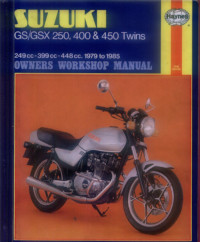
Руководство на английском языке по техническому обслуживанию и ремонту мотоциклов Suzuki GS250/GS400/GS450 и GSX250/GSX400/GSX450 1979-1985 годов выпуска.
- Издательство: Haynes Publishing
- Год издания: 1986
- Страниц: 236
- Формат: PDF
- Размер: 51,6 Mb
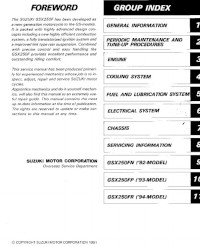
Руководство на английском языке по ремонту мотоциклов Suzuki GSX250F.
- Издательство: Suzuki Motor Corporation
- Год издания: 1991
- Страниц: 229
- Формат: PDF
- Размер: 6,9 Mb
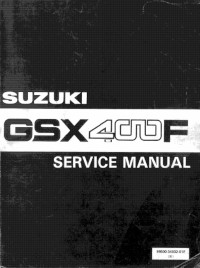
Руководство на английском языке по ремонту мотоциклов Suzuki GSX400F.
- Издательство: Suzuki Motor Corporation
- Год издания: —
- Страниц: 292
- Формат: PDF
- Размер: 39,9 Mb
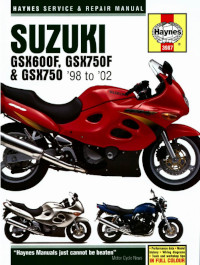
Руководство на английском языке по техническому обслуживанию и ремонту мотоциклов Suzuki GSX600F, GSX750 и GSX750F 1998-2002 годов выпуска.
- Издательство: Haynes Publishing
- Год издания: 2003
- Страниц: —
- Формат: JPG
- Размер: 64,1 Mb
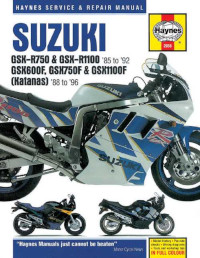
Руководство на английском языке по техническому обслуживанию и ремонту мотоциклов Suzuki GSX600F Katana, GSX750F Katana, GSX1100F Katana 1988-1996 годов выпуска и GSX-R750, GSX-R1100 1985-1992 годов выпуска.
- Издательство: Haynes Publishing
- Год издания: —
- Страниц: 256
- Формат: PDF
- Размер: 37,5 Mb
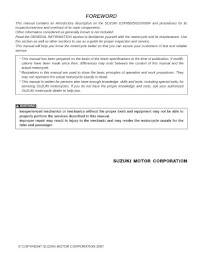
Руководство на английском языке по ремонту мотоциклов Suzuki GSF650, GSF650S и GSX650F.
- Издательство: Suzuki Motor Corporation
- Год издания: 2007
- Страниц: 620
- Формат: PDF
- Размер: 28,9 Mb
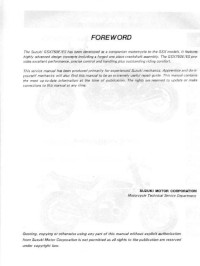
Руководство на английском языке по ремонту мотоциклов Suzuki GSX750E и GSX750ES 1984-1986 годов выпуска.
- Издательство: Suzuki Motor Corporation
- Год издания: —
- Страниц: 309
- Формат: PDF
- Размер: 18,9 Mb
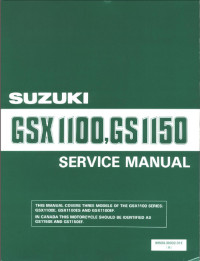
Руководство на английском языке по ремонту мотоциклов Suzuki GS1150 и GSX1100.
- Издательство: Suzuki Motor Corporation
- Год издания: —
- Страниц: 306
- Формат: PDF
- Размер: 42,4 Mb
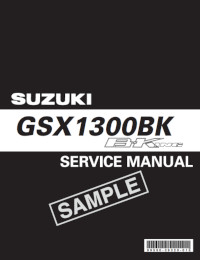
Руководство на английском языке по ремонту мотоциклов Suzuki GSX1300BK B-King.
- Издательство: Suzuki Motor Corporation
- Год издания: 2007
- Страниц: 686
- Формат: PDF
- Размер: 35,6 Mb

Руководство на английском языке по ремонту мотоциклов Suzuki GSX1300R.
- Издательство: Suzuki Motor Corporation
- Год издания: —
- Страниц: 645
- Формат: PDF
- Размер: 13,9 Mb
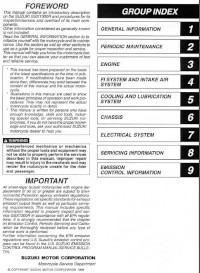
Сборник руководств на английском языке по ремонту мотоциклов Suzuki GSX1300R.
- Издательство: Suzuki Motor Corporation
- Год издания: 1999/2000/2001
- Страниц: 503/31/18
- Формат: PDF
- Размер: 107,6 Mb
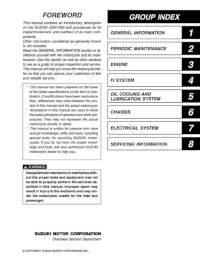
Руководство на английском языке по ремонту мотоциклов Suzuki GSX1400.
- Издательство: Suzuki Motor Corporation
- Год издания: 2001
- Страниц: 354
- Формат: PDF
- Размер: 23,6 Mb
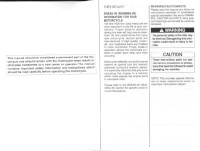
Руководство на английском языке по эксплуатации и техническому обслуживанию мотоциклов Suzuki GSX1400.
- Издательство: Suzuki Motor Corporation
- Год издания: —
- Страниц: 37
- Формат: PDF
- Размер: 6,0 Mb


